.
10.06.2016
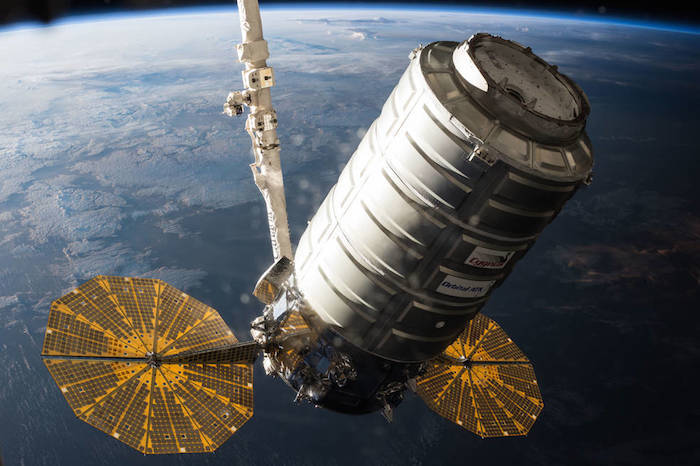
The Orbital ATK Cygnus cargo ship is seen after final approach to the International Space Station. The vehicle was captured at 6:51 a.m. EDT March 26 using the space station's Canadarm2 robotic arm by Expedition 47 Commander Tim Kopra. The unmanned cargo craft was then bolted to the Earth-facing port on the Unity module at 10:52 a.m. Orbital ATK’s fifth cargo delivery flight under its Commercial Resupply Services contract delivered over 7,700 pounds of cargo and included equipment to support some 250 experiments during Expeditions 47 and 48.
Credits: NASA
-
After delivering almost 7,500 pounds of cargo to support dozens of science experiments from around the world, the Orbital ATK Cygnus cargo spacecraft is set to leave the International Space Station Tuesday, June 14. NASA Television will provide live coverage of Cygnus' departure beginning at 9 a.m. EDT.
Ground controllers will detach the Cygnus spacecraft, which arrived at the station March 26, from the Earth-facing side of the station's Unity module using the Canadarm2 robotic arm. Robotics controllers will maneuver Cygnus into place and Expedition 47 robotic arm operators Tim Kopra of NASA and Tim Peake of ESA (European Space Agency) will give the command for its 9:30 a.m. release.
Five hours after departure, the Saffire-I experiment will take place onboard the uncrewed cargo craft. Saffire-I provides a new way to study a realistic fire on a spacecraft. This hasn’t been possible in the past because the risks for performing such studies on crewed spacecraft are too high. Instruments on the returning Cygnus will measure flame growth, oxygen use and more. Results could determine microgravity flammability limits for several spacecraft materials, help to validate NASA’s material selection criteria, and help scientists understand how microgravity and limited oxygen affect flame size. The investigation is crucial for the safety of current and future space missions.
Cygnus also will release five LEMUR CubeSats from an external deployer June 15, part of a remote sensing satellite constellation that provides global ship tracking and weather monitoring. The vehicle will remain in orbit until Wednesday, June 22, when its engines will fire twice, pushing it into Earth's atmosphere where it will burn up over the Pacific Ocean. NASA TV will not provide a live broadcast of the Cygnus deorbit burn and re-entry.
Experiments delivered on Cygnus supported NASA and other research investigations during Expeditions 47 and 48, including studies in biology, biotechnology, physical science and Earth science -- research that impacts life on Earth, and also will help us on the journey to Mars. Investigations studied realistic fire scenarios on a space vehicle, enabled the first space-based observations of meteors entering Earth’s atmosphere from space, explored how regolith behaves and moves in microgravity, tested a gecko-inspired adhesive gripping device that can stick on command in the harsh environment of space, and added a new 3-D printer in microgravity.
The Cygnus resupply craft launched March 22 on a United Launch Alliance Atlas V rocket from Cape Canaveral Air Force Station, Florida, for the company’s fifth NASA-contracted commercial resupply mission.
Quelle: NASA
-
Update: 14.06.2016
.
ISS-LIVE:

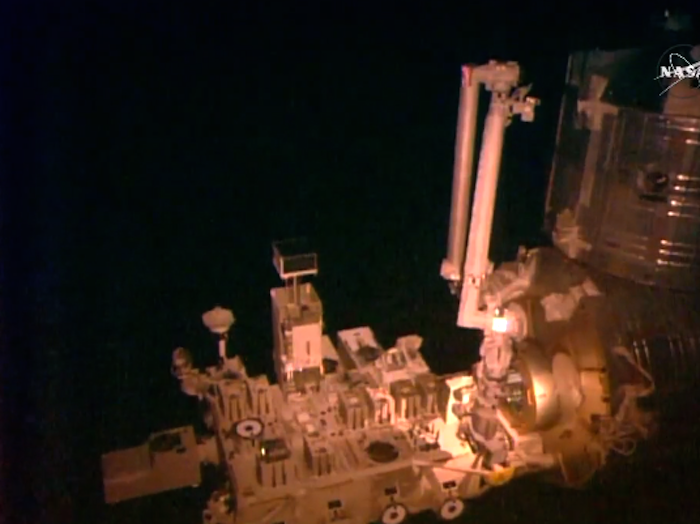
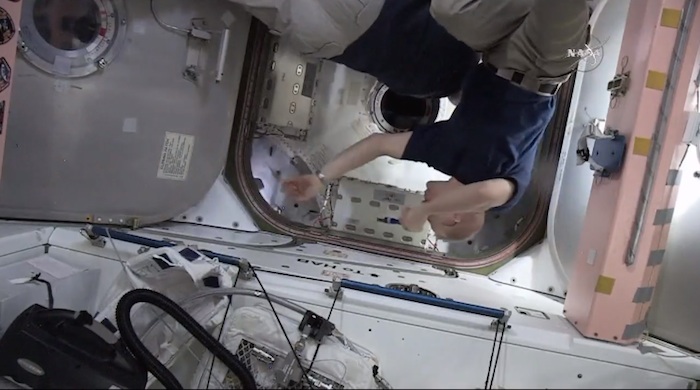
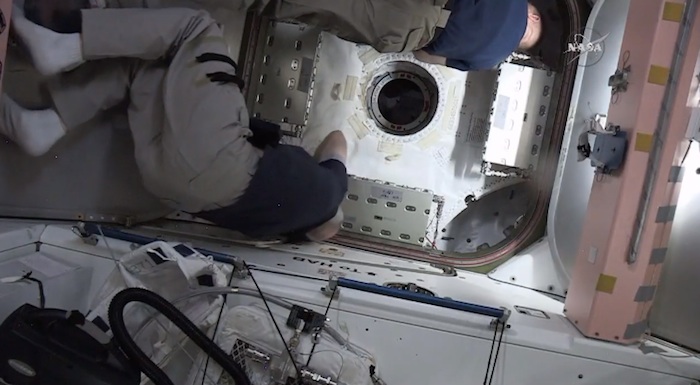
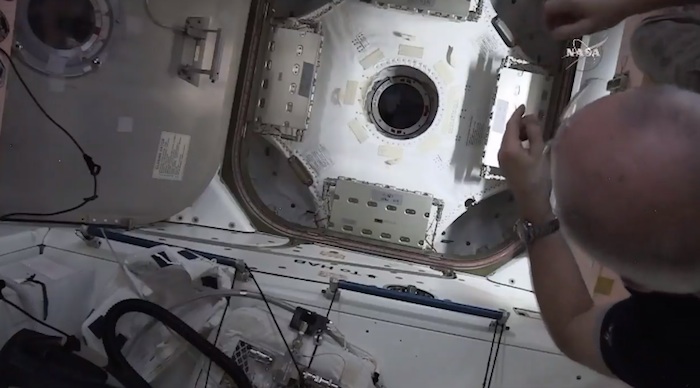

...
Watch Astronauts Release Spacecraft from Robotic Arm
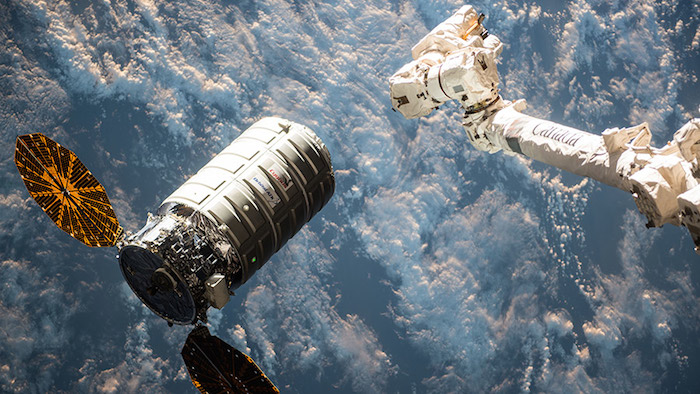
The Canadarm2 robotic arm reaches out to capture the Cygnus spacecraft March 26.
Live coverage began at 9 a.m. EDT on NASA Television of the departure of Orbital ATK’s Cygnus cargo spacecraft from the International Space Station. Release from the station’s Unity module is scheduled for 9:30 a.m.
The Cygnus spacecraft arrived at the International Space Station March 26, delivering almost 7,500 pounds of cargo and science investigations. Experiments delivered on Cygnus supported NASA and other research during Expeditions 47 and 48, including studies in biology, biotechnology, physical science and Earth science — research that impacts life on Earth, and also will help us on the journey to Mars. Investigations studied realistic fire scenarios on a space vehicle, enabled the first space-based observations of meteors entering Earth’s atmosphere from space, explored how regolith behaves and moves in microgravity, tested a gecko-inspired adhesive gripping device that can stick on command in the harsh environment of space, and added a new 3-D printer in microgravity.
-
Robotic Arm Releases Cygnus Before Fire Experiment Starts

The Orbital ATK Cygnus spacecraft departs the International Space Station after its release from the Canadarm2. Credit: NASA TV
-
Expedition 47 robotic arm operator Tim Kopra of NASA commanded the International Space Station’s Canadarm2 robotic arm to release the Cygnus spacecraft at 9:30 a.m. EDT while the space station was flying above Paraguay. Earlier, ground controllers detached Cygnus from the station and maneuvered it into place for its departure.
After Cygnus is a safe distance away, ground controllers at Glenn Research Center in Cleveland, Ohio will initiate the sequence for Saffire-1, and controllers at Orbital ATK in Dulles, Virginia, will activate the experiment. Cygnus will continue to orbit Earth for up to eight days as it transmits hi-resolution imagery and data from the Saffire experiment. Following complete data transmission, the Cygnus spacecraft will complete its destructive entry into the Earth’s atmosphere on June 22. NASA TV will not provide a live broadcast of the Saffire experiment or the Cygnus deorbit burn and re-entry, but imagery from Saffire will be posted on NASA.gov as it becomes available.
The Cygnus resupply craft launched March 22 on a United Launch Alliance Atlas V rocket from Cape Canaveral Air Force Station, Florida, for the company’s fifth NASA-contracted commercial resupply mission.
.
NASA Ignites Fire Experiment Aboard Space Cargo Ship
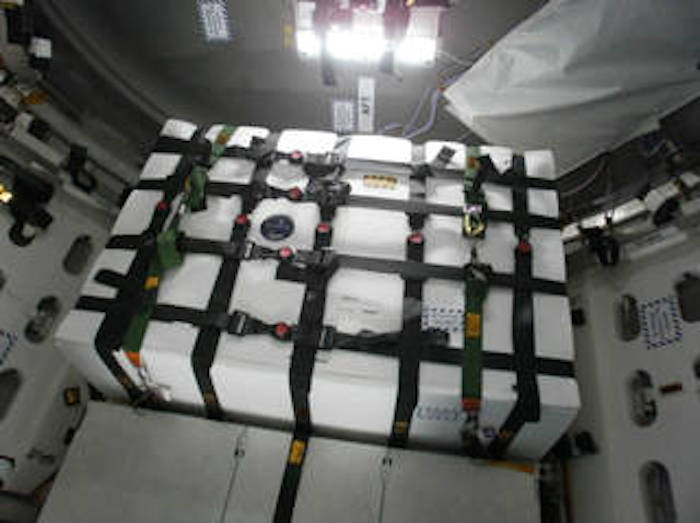
The Saffire-I hardware is shown strapped into the Orbital ATK Cygnus Pressurized Cargo Module.
.
Understanding how fire spreads in a microgravity environment is critical to the safety of astronauts who live and work in space. And while NASA has conducted studies aboard the space shuttle and International Space Station, risks to the crew have forced these experiments to be limited in size and scope. Fire safety will be a critical element as NASA progresses on the journey to Mars and begins to investigate deep space habitats for long duration missions.
The Spacecraft Fire Experiment (Saffire) is a three-part experiment that will be conducted over the course of three flights of Orbital ATK’s Cygnus vehicle to investigate large-scale flame spread and material flammability limits in long duration microgravity.
The Saffire-I experiment enclosure is approximately half a meter wide by 1 meter deep by 1.3 meter long and consists of a flow duct and avionics bay. Inside the flow duct is the sample to be burned which is a cotton-fiberglass material blend 0.4 m wide by 1 meter long. When commanded by Orbital ATK and Saffire ground controllers operating from Dulles, VA, it will be ignited by a hot wire. Previous to this experiment, the largest fire experiment that has been conducted in space is about the size of an index card.
After the experiment has been ignited, the Cygnus will continue to orbit Earth for up to eight days as it transmits high-resolution imagery and data from the Saffire experiment. Following complete data transmission, the Cygnus spacecraft will complete its destructive entry into the Earth’s atmosphere.
Saffire-I launched inside the Cygnus spacecraft atop the United Launch Alliance (ULA) Atlas V launch vehicle on March 22, 2016. Space Station Crew members successfully grappled Cygnus to the space station on March 26. The Saffire experiments were developed at NASA Glenn Research Center by the Spacecraft Fire Safety Demonstration Project and sponsored by the Advanced Exploration Systems (AES) Division of NASA’s Human Exploration and Operations Mission Directorate. AES pioneers new approaches for rapidly developing prototype systems, demonstrating key capabilities, and validating operational concepts for future human missions beyond low-Earth orbit. AES activities are uniquely related to crew safety and mission operations in deep space, with a strong focus on future vehicle development.
More: Watch this video to learn more about Saffire.
Saffire-I Updates
July 14, 2016
9:30 a.m.
Expedition 47 robotic arm operator Tim Kopra of NASA commanded the International Space Station’s Canadarm2 robotic arm to release the Cygnus spacecraft at 9:30 a.m. EDT while the space station was flying above Paraguay. Earlier, ground controllers detached Cygnus from the station and maneuvered it into place for its departure.
After Cygnus is a safe distance away, ground controllers at Glenn Research Center in Cleveland, Ohio will initiate the sequence for Saffire-1, and controllers at Orbital ATK in Dulles, Virginia, will activate the experiment. Cygnus will continue to orbit Earth for up to eight days as it transmits hi-resolution imagery and data from the Saffire experiment. Following complete data transmission, the Cygnus spacecraft will complete its destructive entry into the Earth’s atmosphere on June 22.
Quelle: NASA
-
Update: 15.06.2016
.
Orbital ATK's Cygnus Spacecraft Begins Next Phase of OA-6 Mission, Conducting Science in Space
Cygnus Departs International Space Station Today After Successfully Delivering and Removing Vital Cargo
The “S.S. Rick Husband” Begins Series of Experiments, Marking First Time Cygnus Used as a Science Platform
Dulles, Virginia 14 June 2016 – Orbital ATK, Inc. (NYSE: OA), a global leader in aerospace and defense technologies, today announced that the “S.S. Rick Husband” Cygnus™ spacecraft successfully departed from the International Space Station at 9:30 a.m. EDT, completing an 81-day stay at the orbiting laboratory. The mission, known as OA-6, began on March 22, 2016 when Cygnus launched aboard a United Launch Alliance Atlas V rocket from Cape Canaveral Air Force Station, Florida. Cygnus delivered 7,900 pounds (3,600 kilograms) of cargo and science experiments to astronauts aboard the station. Prior to its departure, the astronauts loaded the unmanned cargo module with approximately 4,087 pounds (1,854 kilograms) of items for disposal.
Orbital ATK’s fifth mission under NASA’s Commercial Resupply Services-1 (CRS-1) contract now begins its second phase before the planned reentry of Cygnus into Earth’s atmosphere. Cygnus will conduct three, in-orbit science experiments: the Spacecraft Fire Experiment-I (Saffire-I), the deployment of five CubeSat satellites from the NanoRacks CubeSat Deployer and the Reentry Breakup Recorder (REBR) test.
“Cygnus had a successful, two-and-a-half-month stay at the International Space Station, delivering vital cargo to the astronauts,” said Frank Culbertson, President of Orbital ATK’s Space Systems Group. “Now, the work continues as we demonstrate expanded capabilities for Cygnus beyond its core cargo delivery function. The next phase of this mission marks the first time that Cygnus will serve as a research platform to support science experiments that enable deep space exploration. Our ability to conduct these tests further highlights the versatility and flexibility that Cygnus offers to our customers.”
The Spacecraft Fire Experiment-I (Saffire-I) will feature the first of three tests to study the behavior of large fires in microgravity. Following departure from the International Space Station, engineers will remotely conduct the first Saffire experiment. Onboard Cygnus, the experiment developed at NASA’s Glenn Research Center with the support of NASA’s Advanced Exploration Systems Division will intentionally ignite and record a large-scale fire that will grow and advance until it burns itself out.
Next, using a deployer provided by NanoRacks, the “S.S. Rick Husband” will place five CubeSats into orbit to conduct their own autonomous missions.
The final experiment to take place aboard Cygnus features the Reentry Breakup Recorder (REBR). REBR will measure and record data during Cygnus’ safe destructive reentry into Earth’s atmosphere. The scheduled date for reentry is June 22, officially ending the OA-6 mission.
Stay informed with real-time updates on the science experiments aboard Cygnus through Orbital ATK’s Twitter account: https://twitter.com/OrbitalATK.
Quelle: Orbital ATK
-
Update: 15.06.2016
.
NASA Glenn Successfully Ignites Largest Fire Experiment in Space
Engineers at NASA's Glenn Research Center in Cleveland, Ohio and Orbital ATK in Dulles, Virginia successfully conducted the first remote Spacecraft Fire Experiment, or Saffire I, carried inside an Orbital ATK Cygnus cargo vehicle that departed the International Space Station on Tuesday, June 14. The experiment’s purpose is to learn how a fire might behave in a spacecraft after leaving Earth’s atmosphere. Understanding how fire spreads in a microgravity environment is critical to the safety of astronauts who live and work in space as NASA prepares for long duration missions on the journey to Mars.
Cygnus spacecraft and robotic arm of space station closeup with Earth visible below
“The first of our planned three Saffire experiments operated as designed which is a great credit to all the people at NASA who played a role in its development,” said Gary A. Ruff, NASA’s Spacecraft Fire Safety Demonstration Project manager. “The success of this experiment opens the door to future large combustion experiments in the microgravity environment and directly supports the development of technologies and materials that will make deep space exploration spacecraft safer.”
Launched to the space station in an Orbital ATK Cygnus resupply cargo vehicle on March 22, Saffire remained in Cygnus for 81 days as supplies were offloaded by the station’s crew. After the supplies were offloaded and replaced with space station trash, Cygnus departed. Cygnus was then maneuvered a safe distance from the space station before the experiment began.
The Saffire experiment took place in a 3-foot by 3-foot by 5-foot tall module equipped to characterize and document the burning of a sample material approximately 16 inches wide and 37 inches long. Images and data captured from inside the module will be transmitted to Orbital ATK and relayed to Glenn over a period of up to eight days prior to Cygnus’ destructive reentry to Earth. Researchers at Glenn and 10 other U.S. and international government agencies and universities will analyze the data in the coming weeks.
Two subsequent flight experiments consist of Saffire-II, which will assess oxygen flammability limits using samples that are 2 inches wide and 12 inches long; and Saffire-III, which will assess a second large-scale microgravity fire. Each module will be flown aboard an Orbital ATK Cygnus cargo vehicle during a resupply mission to the space station.
The Spacecraft Fire Safety Demonstration Project that developed the Saffire flight systems is sponsored by the Advanced Exploration Systems Division in NASA’s Human Exploration and Operations Mission Directorate. The three Saffire units used components manufactured in facilities at Glenn, NASA’s Johnson Space Center in Houston and White Sands Test Facility in Las Cruces, New Mexico. Three additional experiment modules will be designed and built by engineers at Glenn and launched in Orbital ATK cargo vehicles beginning in 2018.
Quelle: NASA
6589 Views
